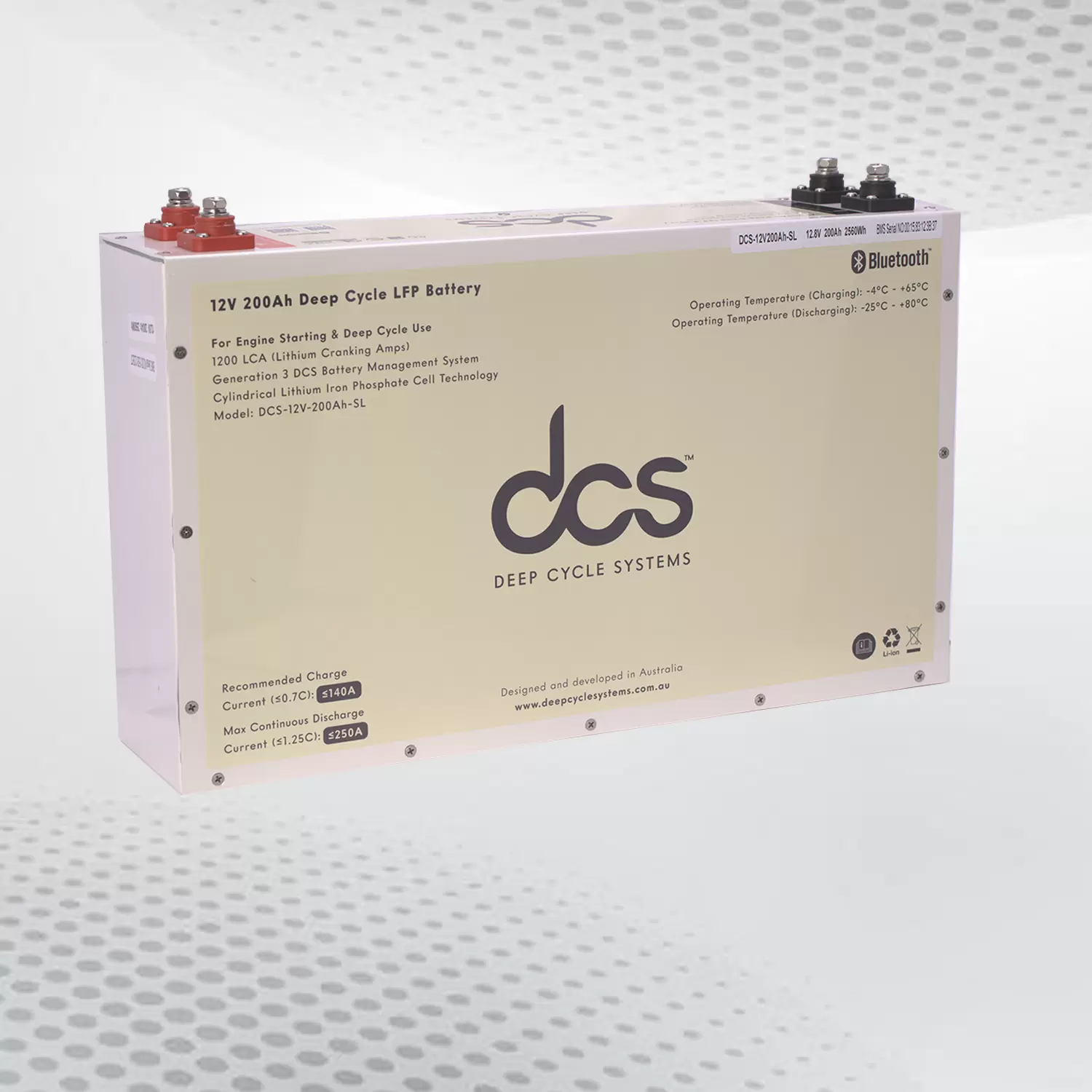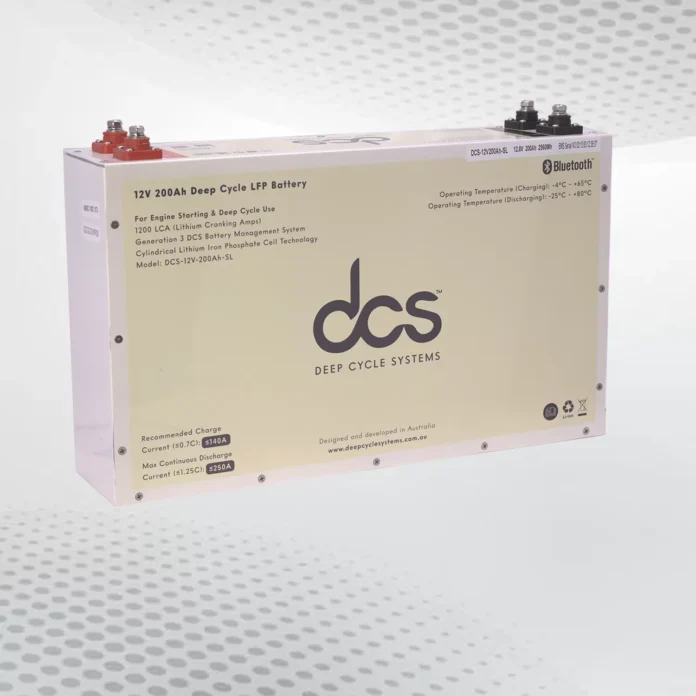Regarding energy storage solutions, the 200ah lithium battery has become increasingly popular due to its high efficiency and long lifespan. In this blog post, we will delve into the intricacies of this powerful energy source, exploring its advantages, potential applications, maintenance tips, charging and discharging processes, common issues, safety features, and more.
What Is A 200-Ah Lithium Battery?
A 200-ah lithium battery is a high-capacity, rechargeable energy source utilising advanced lithium-ion technology for energy storage. When we refer to “200-ah”, we’re alluding to its capacity in ampere-hours, a unit of measure that reveals how much electricity it can dispense consistently over one hour before completely drained. This power, married with the ability of lithium-ion batteries to expertly conduct ions between the anode and cathode, underscores the battery’s ideal suitability for high-usage applications.
With their lightweight and compact attributes, these lithium-ion batteries help close the gap between energy storage needs and mobility demands. Its distinct capacity extends its versatility, making it fit for numerous applications and meeting the need for resilient, enduring power in multiple industries. Moreover, the technology driving these batteries fuses flawlessly into systems requiring stable energy without incurring the heavy burden or bulk commonly associated with other battery types.
The Advantages of Using a 200-Amp Lithium Battery
Its exceptional energy density is among the primary benefits of deploying a 200-amp lithium battery. This characteristic enables the storage of significant energy volumes within a compact and light framework, an essential factor for applications constrained by spatial and weight limitations. For instance, in electric vehicles and portable electronic devices, where efficiency and mobility are paramount, the 200-amp lithium battery proves indispensable.
Further, these batteries boast an extensive cycle life, supporting numerous charge and discharge cycles without substantial degradation. This trait ensures enduring reliability and reduces the need for frequent replacements, offering both economic and environmental benefits. Moreover, lithium-ion batteries’ rapid charging capabilities allow quicker energy replenishment than alternative battery technologies. This efficiency enhances convenience and contributes to operational effectiveness in various applications.
The self-discharge rate of these batteries is notably low, ensuring minimal energy loss when the battery is not in active use. This aspect benefits applications requiring long-term, dependable energy storage without constant maintenance. The absence of memory effect in lithium-ion batteries means they can be recharged before being fully depleted without affecting their future capacity, thereby providing flexible and efficient energy management solutions for diverse needs.
Potential Applications of a Lithium Ion Battery 200ah
The lithium ion battery 200ah‘s wide-ranging usefulness covers a variety of sectors, all of which benefit from its high energy capacity and efficiency. In electric vehicles (EVs), these batteries are essential, providing the necessary power to travel long distances without frequent stops for recharging. Their ability to recharge quickly significantly improves the practicality of EVs for everyday use.
Furthermore, the renewable energy sector greatly values 200-ah lithium batteries for energy storage solutions. These batteries efficiently store excess energy generated from solar panels during peak sunlight hours, ensuring a steady electricity supply even during periods of low sunlight or at night. This capability is crucial for residential and commercial settings that aim to reduce reliance on the grid and lower energy costs.
Emergency power systems also depend on these robust batteries to provide a reliable backup power source during outages. Continuous operation is essential in critical environments such as hospitals, data centres, and telecommunication facilities; here, the 200-ah lithium battery provides peace of mind with its dependable energy reserve. For those who enjoy off-grid living, the 200-ah lithium battery offers an opportunity to achieve energy independence.
Maintaining Your 200-Ah Lithium Battery for Optimal Performance
A few critical maintenance steps are essential to guarantee the enduring efficiency and durability of your 200-ah lithium battery. It’s advisable to keep the battery in a cool and dry environment, as extreme temperatures can significantly impact its performance and lifespan.
Regular monitoring to avoid overcharging or excessively deep discharging is vital; such extremes strain the battery, leading to potential deterioration over time. Adherence to the manufacturer’s charging and discharging recommendations will ensure that the battery remains within its optimal operational parameters. It is also imperative to conduct periodic inspections for any signs of physical damage or wear, which could preemptively address issues before they escalate.
Keeping the battery terminals clean and ensuring a secure connection can prevent power loss and potential safety risks. By implementing these maintenance practices, you can significantly enhance the operational efficiency and extend the service life of your 200-ah lithium battery, ensuring it continues to meet your energy needs effectively.
 Charging and Discharging A 200-Ah Lithium-Ion Battery
Charging and Discharging A 200-Ah Lithium-Ion Battery
Correct handling during the charging and discharging process is pivotal to optimising the service life and performance of a 200-ah lithium-ion battery. Adherence to manufacturer-provided guidelines cannot be overstated; using a charger specifically compatible with your lithium-ion battery is essential to prevent potential damage. Charging should ideally occur within the temperature range recommended by the manufacturer, as extreme cold or heat can adversely affect the battery’s efficiency and safety.
When discharging, it’s crucial to avoid depleting the battery entirely before recharging. Lithium-ion batteries benefit from partial discharge cycles, unlike other battery types requiring full discharge to maintain health. Allowing the battery to drop to a critically low level can induce undue stress, hastening wear and diminishing capacity. Incorporating a balanced approach to charging cycles — neither overcharging nor allowing the battery to frequently hit a fully depleted state — plays a significant role in maintaining the battery’s integrity.
Monitoring the battery’s voltage and temperature during charging and discharging can help identify any anomalies early, safeguarding against potential issues that could impair functionality. Utilising smart charging systems that automatically halt charging once optimal battery levels are reached can further enhance longevity.
Troubleshooting Common Issues with A 200-Ah Lithium Battery
Encountering problems with a 200-ah lithium battery can be disconcerting, yet many common issues have straightforward remedies. Overheating is a frequent concern and can often be mitigated by ensuring the battery is positioned in a well-ventilated area away from direct sunlight.
Recalibrating the battery by performing a full charge cycle – from complete discharge to 100% charge – may help restore its efficacy if capacity seems diminished. Inspecting connections for corrosion or looseness may prove beneficial if you notice sudden voltage drops. Firmware updates for the battery management system can resolve some performance issues, enhancing efficiency and safety.
Utilising only the specified charger and adhering to the recommended charging practices to prevent these common problems is paramount. When issues persist, contacting the manufacturer or a professional technician is advisable. They can provide expert guidance and, if necessary, professional servicing to ensure your battery’s optimal performance and longevity. Remember, preventative measures and prompt action when issues arise are key to maintaining the health of your 200-ah lithium battery.
Maximising the Lifespan of Your 200-Ah Lithium Battery
Adhering to specific care and usage guidelines is paramount to ensure the long-term durability and efficiency of your 200-ah lithium battery. Maintaining the battery within the recommended temperature range is crucial; excessive heat or cold can degrade its components and reduce lifespan. It is also advisable to avoid placing the battery in environments where it might be susceptible to mechanical shocks or vibrations which can cause internal damage.
Implementing a disciplined charging routine plays a critical role in longevity; avoid allowing the battery to frequently reach a fully depleted state before recharging. Instead, partial discharge cycles are preferred, as they help maintain the battery’s health over time. Moreover, a high-quality charger designed for lithium-ion batteries ensures that the charging process is optimised for your battery’s specific needs, preventing overcharging and undercharging.
Periodic calibration, where the battery is fully discharged and then fully charged, can also be beneficial in recalibrating the battery’s charge measurement systems. By observing these practices, you can significantly enhance the life expectancy of your 200-ah lithium battery, ensuring it continues to provide reliable energy storage and power for its intended applications.
Safety Features of a 200 Amp Lithium Battery
The 200-amp lithium battery utilises intricate safety mechanisms specifically engineered to reduce the likelihood of hazardous incidents and guarantee safe use. Integral to the operation of these batteries, built-in temperature sensors are installed that tirelessly oversee any abnormal increase in heat, subsequently initiating a series of protective actions to prevent the device from overheating. These actions might include reduced power output, halting the charging process, or triggering an automatic shutdown.
A particularly essential feature of these batteries is the voltage monitoring systems that diligently scrutinise the 200 amp lithium battery‘s operational characteristics to circumvent potential overcharging or deep discharging, which could considerably degrade the battery’s performance over time. On top of these, automatic cut-off mechanisms are employed to disconnect the battery’s link to the load or charger if unusual occurrences such as short-circuits or excessive current draw are detected.
Collectively, these safety features act as an extensive safety framework, protecting not only the battery itself, but also the equipment it powers and the surroundings in which it functions. Users are advised to get to grips with these safety components and strictly follow recommended usage guidelines to maximise their experience with the 200-amp lithium battery.
FAQ’s
What applications are suitable for a 200-Ah lithium-ion battery?
A 200-Ah lithium-ion battery finds applications in various fields, including renewable energy storage, electric vehicles, marine propulsion systems, and off-grid power solutions. It is favored in situations requiring substantial energy storage and prolonged usage without frequent recharging.
How does a 200Ah lithium battery compare to other battery types?
A 200Ah lithium battery offers higher energy density, a longer lifespan, and faster charging capabilities compared to traditional lead-acid batteries. It also outperforms other battery chemistries in terms of efficiency and weight-to-energy ratio, making it a preferred choice for many modern applications.
What are the advantages of using a 200-Ah lithium-ion battery?
The advantages of a 200-Ah lithium-ion battery include its high energy density, lightweight construction, and ability to deliver consistent power output over multiple charge cycles. It also boasts a lower self-discharge rate and does not suffer from memory effect like other battery types.
How long does a 200-Ah lithium-ion battery last?
The lifespan of a 200-Ah lithium-ion battery depends on various factors such as usage patterns, charging habits, and environmental conditions. Generally, these batteries can endure hundreds to thousands of charge-discharge cycles, translating to several years of reliable service life.
What safety precautions should be considered when using a 200-Ah lithium-ion battery?
When using a 200-Ah lithium-ion battery, it is essential to follow manufacturer guidelines for proper charging, discharging, and storage. Avoid exposing the battery to extreme temperatures, overcharging, or physical damage, as these can lead to safety hazards such as thermal runaway or cell rupture. Regular inspection and maintenance are crucial to ensure safe and efficient operation.
Conclusion
The 200-ah lithium-ion battery represents a pivotal advancement in energy storage technology, offering unparalleled efficiency, longevity, and safety for many applications. Users can maximise their benefits by adhering to maintenance guidelines and utilising these batteries within their operational parameters. Whether for renewable energy systems, electric vehicles, or off-grid living, the 200-ah lithium battery is a testament to the strides made in sustainable and reliable power sources. Its adoption not only reflects a commitment to innovation but also to a greener, more energy-efficient future.
| Other Good Articles to Read |
| Blogs-Nation |
| Blogs-Peoples |
| Bryan Smith Blogs |
| intellect blogs |
| the fault in our blogs |
| blogs eu |
| oz forums |
| recruitment blogs |
| zet blogs |
| id blogs |
| Blog Studio legale |
| blogs map |
| Related Business Listings |
| Contact Directory |
| Local Business Profiles |

